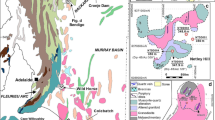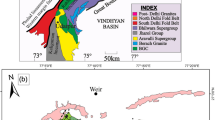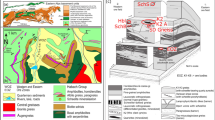Abstract
The present work deals with the geology, mineralogy, geochemistry, and origin of the metagabbroic-hosted manganese deposits at Wadi Maliek in the southern Eastern Desert of Egypt. The manganese veins are found in the shear zones and channel ways of the fault planes within the metagabbroic rocks pointing to those hydrothermal solutions carrying manganese and iron load penetrating along these fractures. These faults are striking N 80° E–S 80° W with dipping 65°. These veins vary in thickness from 15 cm up to 125 cm wide; each vein may show difference in thickness from bottom to top. Microscopic examinations, X-ray diffraction, infrared spectral, differential thermal (DTA), thermogravimetric (TGA), and ESEM-EDAX analyses revealed that the manganese minerals consist mainly of pyrolusite, psilomelane, and ramsdellite. Goethite and hematite are the common iron minerals. Petrographically, the manganese deposits can be classified into three ore types based on the predominance of manganese and iron minerals: manganese, manganese–iron, and iron ore types. The geochemistry of Maliek deposits indicated that the total averages of some major oxides in manganese, manganese–iron, and iron ore types are respectively as follows: SiO2 (15.64%, 11.52%, and 20.58%), MnO (39.9%, 17.81%, and 0.77%), FeO* (7.13%, 33.31%, and 37.08%), CaO (5.89%, 5.82%, and 5.32%), and Na2O (1.04%, 1.61%, and 1.53%). With regard to trace elements, the Maliek manganese deposits are rich in Zn, Ba, Pb, Sr, and V. Based on the geological, mineralogical, and geochemical results, the studied manganese deposits are considered to be precipitated from hydrothermal solution.
Abstract
يتواجد خام المنجنيز في صورة عروق أو عريقات أو جيوب صغيرة داخل صخورَ الميتاجابرو. حيث تملأ عروق المنجنيز الشقوق الموجودة في صخور الجابرو، ويتراوح سمك العرق ما بين 15 سم إلى 125 سم ممتدة في اتجاه (شمال شرق—جنوب غرب) بزاوية ميل 60 درجه. أما جيوب المنجنيز فتكون عادة غير متصلة ومستديرة إلى شبه مستديرة بحيث يتراوح قطر الواحدة ما بين 20 سم إلى 25 سم.
اعتمادا على الدراسه الميكروسكوبية لصخور الميتاجابرو أمكن تقسيمها إلى أربع أنواع أساسيه وهى: الميتاجابرو العادي، الميتاجابرو الغنى بالكوارتز، الدايوريت، الأمفيبوليت.
أظهرت الدراسه الميكروسكوبية التفصيلية للقطاعات الرقيقة والمصقولة لرواسب المنجنيز أنه يتكون من ثلاث أنواع مختلفة من الخامات اعتمادا على نسب معادن المنجنيز والحديد الموجودة فيها وهى: خام المنجنيز، خام الحديد الغنى بالمنجنيز، خام الحديد. كما أظهرت الدراسه الميكروسكوبية مع الأستعانه بتحليل حيود الأشعة السينية والتحليل الطيفي للأشعة تحت الحمراء والتحليل الحراري التفاضلي وكذلك الميكروسكوب الماسح الالكتروني عن وجود معادن البيرولوسيت والبسيلوميلين والرامسديليلت كمصدر لخام المنجنيز، معادن الجيوثيت والهيماتيت كمصدر لخام الحديد بالأضافه إلى وجود شوائب معدنية مثل معادن الكالسيت والكوارتز والأباتيت والكلوريت والميكا والبلاجيوكليز.
أتضح من دراسة الأكاسيد الشائعة أن خام المنجنيز غنى بأكاسيد المنجنيز (39.9%) والسليكون (15.64%) والماغنسيوم (10.04%) والكالسيوم (5.89%) ، بينما خام الحديد الغنى بالمنجنيز يحتوى على نسب عالية من أكاسيد الحديد (33.31%) والمنجنيز (17.81%) والكالسيوم (5.82) والفسفور (0.67%) ، أما خام الحديد فهو غنى بأكاسيد الحديد (37.08%) والسليكون (20.58%) والكالسيوم (5.32%) والفسفور (0.72%.
أتضح من دراسة العناصر الشحيحة أن خام المنجنيز غنى بعناصر النحاس والزنك والباريوم والأسترنشيوم والفاناديوم، بينما خام الحديد الغنى بالمنجنيز يحتوى على نسب عالية من عناصر الكروم والكوبالت والزنك والباريوم والرصاص والأسترنشيوم والفاناديوم، أما خام الحديد فهو غنى بعناصر الكروم والكوبالت والزنك والباريوم والرصاص والفاناديوم.
يعتبر خام المنجنيز من الدرجة المتوسطه حيث تصل متوسط نسبة أكسيد المنجنيز فيه إلى (39.9%)، بينما تصل متوسط نسبة أكسيد المنجنيز في خام الحديد الغنى بالمنجنيز وخام الحديد إلى (17.8، 0.77% بالتتابع) لذا يعد كلا النوعين بأعتبارهما خامات من الدرجة الضئيلة.
تبين من خلال الدراسات السابقة أن هذه الرواسب قد تكونت بفعل صعود المحاليل الساخنه المحملة بالمنجنيز والحديد.


















Similar content being viewed by others
References
Arrhenius G, Tsai AG (1981) Structure, phase transformation and prebiotic catalysis in marine manganate minerals. Scripps Inst Oceanogr Ref Ser 81:1–19
ASTM (1964) Methods of emission spectrochemical analysis, 4th edn. ASTM, Philadelphia
Atia AM, Hegab OA, Morsy AM (1976) Contribution to the mineralogy of manganese deposits of Halaib, South Eastern Desert, Egypt. Bull Fac Sci Mansoura Univ Mansoura Egypt 6:459–474
Bonatti E, Kramer T, Rydell HS (1972) Classification and genesis of submarine iron–manganese deposits in ferromanganese deposits on the ocean floor. In: Horn DR (ed) Classification and genesis of submarine iron–manganese deposits in ferromanganese deposits on the ocean floor. Natural Science Foundation, Washington, pp 149–166
Cox KG, Bell JD, Pankhurst RJ (1979) The interpretation of igneous rocks. Allen and Unwin, London, 450
Cretar DA, Namson J, Chyi MS, DA Williams F (1982) Manganiferous cherts of the Franciscan assemblage: 1. General geology, ancient and modern analogues and implications for hydrothermal convictions at ocean spreading center. Econ Geol 77:519–540
Dorokhin IV, Bogachero EN, Druzhiniv AV, Soboleviski VI, Gorbunov EV (1969) Economic mineral deposits. Higher School, Moscow, 368
El Agami NI, Abu Baker MA, Ibrahim ME, Rashad MA (1999) Mineralogical and geochemical studies on some mineralizations in Halaib area, South Eastern Desert, Egypt. Egy Jour Geol 43(1):27–38
El Shazly EM (1957) Classification of Egyptian mineral deposits. Egypt Jour Geol 1:1–20
Estep PA (1977) Infrared spectroscopy. In: Zassuman J (ed) Physical methods in determinative mineralogy. Academic, New York, p 720
Hewitt DF, Fleischer M (1960) Deposits of the manganese oxides. Econ Geol 55:1–55
Hewitt DF, Fleischer M, Conkln N (1963) Deposits of the manganese oxides. Supplement. Econ Geo 58:1–50
Hietanen AA (1963) On the facies series in the various types of metamorphism. Jour Geol 75:187–214
Ibrahim ME, Saleh GM, Drawish MS, Khalaf MA (2006) Mineralogy and geochemistry of some mineralization associated with Elba ring complex, South Eastern Desert. In: Egypt Inter Con On Geochem. Alex Univ Egypt I, pp 99–115
Irvine TN, Baragar WR (1971) A guide to the chemical classification of the common volcanic rocks. Can Jour Earth Sci 8:523–548
Miyashiro A (1975) Metamorphism and metamorphic belts. George Allen Unwin, London, 429
Neil TM, William LB (1964) Infrared absorption study of metal oxides in the low frequency region (700–240 cm−1). Spectrochim Acta 20:799–808
Neumann BS (1977) Thermal technique. In: Zassuman J (ed) Physical methods in determinative mineralogy. Academic, New York, p 720
Nicholson K (1990) Stratiform manganese mineralization near Inverness, Scotland: a Devonian sublacustrine hot-spring deposit? Miner Deposita 25:126–131
Nicholson K (1992) Contrasting mineralogical–geochemical signatures of manganese oxides: guides to metallogenesis. Econ Geol 87:1253–1264
Panagos AG, Varnavas SP (1984) On the genesis of some manganese deposits from eastern Greece. In: Wauschkuhn A (ed) Syngenesis and epigenesis in the formation of mineral deposits. Spriger, Berlin, pp 553–561
Pearce JA, Cann JR (1973) Tectonic setting of basic volcanic rocks determined using trace element analysis. Earth Planet Sci Lett 19:290–300
Pearce JA, Gale GH (1977) Identification of ore deposition environment from trace elements geochemistry of associated igneous host rocks. Volcanogenic processes in the ore genesis. Spec Publ Geol Soc Lond 7:14–42
Pettijohn FG (1975) Sedimentary rocks, 3rd edn. Harper & Row, New York, p 628
Rona PA (1978) Criteria for recognition of hydrothermal mineral deposits in oceanic crust. Econ Geol 73:135–160
Salem IA, El Kalioubi BA, Abu El Laban SA (2001) Mineralogy, geochemistry and origin of manganese deposits of Abu Ramad area, Southern Eastern Desert, Egypt. In: 5th Intern. Conf on Geoch Alex Univ Egypt, pp 441–467
Shah MT, Khan A (1999) Geochemistry and origin of Mn-deposits in the Waziristan ophiolite complex, North Waziristan, Pakistan. Miner Deposita 34:697–704
Streckeisen A (1976) To each plutonic rock its proper name. Earth Sci Rev 12:1–13
Sugisaki R, Ohashi M, Sugitami K, Suzuki K (1987) Compositional variations in manganese micronodules: a possible indicator of sedimentary environments. Jour Geol 95:433–545
Wilson M (1989) Igneous petrogenesis. Harper Collins Academic, London, p 466
Author information
Authors and Affiliations
Corresponding author
Rights and permissions
About this article
Cite this article
Salem, I.A., Ibrahim, M.E. & Abd El Monsef, M. Mineralogy, geochemistry, and origin of hydrothermal manganese veins at Wadi Maliek, Southern Eastern Desert, Egypt. Arab J Geosci 5, 385–406 (2012). https://doi.org/10.1007/s12517-010-0195-1
Received:
Accepted:
Published:
Issue Date:
DOI: https://doi.org/10.1007/s12517-010-0195-1




